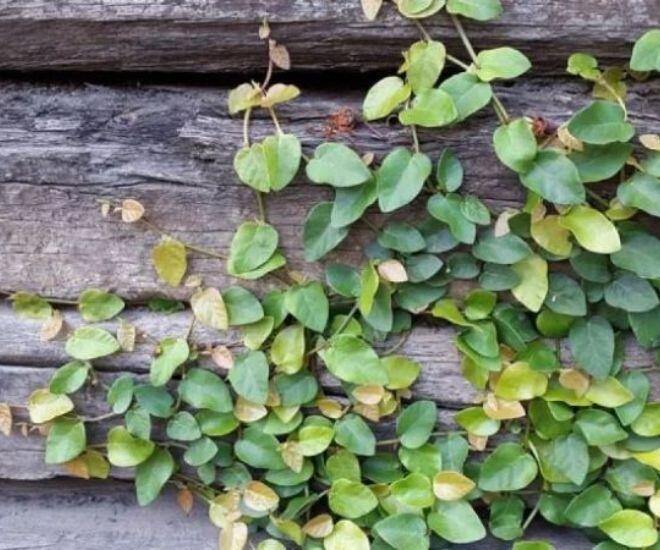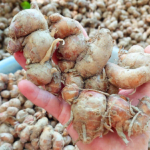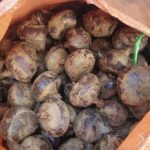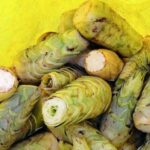
In recent times, a humble vegetable has been making waves in the world of gourmet cuisine. Once a modest ingredient sold at local markets and grocers, the “vay oc” (translating to “snail shell”) has undergone a remarkable transformation. With prices soaring from a few thousand to 70,000 VND per kilogram, it has become a sought-after delicacy. But what is the story behind this unassuming vegetable’s sudden rise to fame? It all begins with a resilient vine that climbs its way to success.
Belonging to the Ficus pumila L. species, the vay oc vine is native to the lush landscapes of Asia, particularly Vietnam’s mountainous regions, where it thrives in the cool, moist environments of forests, fields, and hillsides. Growing up to several meters in length, the vine is characterized by its rough, uneven texture and the presence of air roots that allow it to firmly attach itself to surfaces. Interestingly, the vay oc has two types of branches. The first, present on young vines, bears no flowers and has small, flat leaves that resemble snail shells, giving the plant its charming namesake. As the vine matures, a second type of branch emerges, bearing larger, thicker leaves and signaling the imminent arrival of harvest season. A distinctive feature of the vine is the presence of white sap within its young stems and leaves.

What is commonly referred to as the “vay oc fruit” is actually the concave base of the flower, resembling a fig or mulberry in shape. These “fruits” start off green and transform into a vibrant red as they ripen, with peak season falling between August and September. During this time, locals harvest the vay oc to create culinary delights and traditional medicines. One of the most renowned dishes made from ripe vay oc is the “thach Ai Ngoc,” a refreshing and nutritious dessert crafted from the seeds of the fruit. More than just a tasty treat, this dessert represents a delicate culinary art that celebrates the fusion of nature and culture.
Beyond its culinary appeal, the vay oc is also revered for its medicinal properties in traditional folk medicine. According to Eastern medicine practitioners, the unripe fruit is believed to aid in treating lactation issues in postpartum women and addressing conditions like seminal emission and impotence in men. Meanwhile, the slightly more acidic branches and leaves are used to alleviate conditions related to wind, dampness, blood stagnation, and toxins. Historically, these plant parts have been relied upon to treat ailments such as rheumatism, dysentery, and trauma. With such a diverse range of therapeutic benefits, the vay oc has elevated its status from a mere wild vegetable to a precious medicinal herb.

Today, the vay oc is not only sourced from the wild but is also cultivated by families as ornamental plants and natural fences. Its rapid growth and adaptability make propagation and cutting a breeze, providing households with an additional source of income while contributing to the conservation and development of this valuable plant species. However, a word of caution: when purchasing fresh vay oc, sellers often advise consumers to use it immediately and avoid storing it in the refrigerator to prevent bruising and spoilage. This delicate nature of the vay oc underscores its preciousness and warrants immediate consumption to truly appreciate its freshness and flavor.
The vay oc, a wild vine, has embarked on an extraordinary journey from the treacherous cliffs and ancient trees of the deep forests to the dining tables of city dwellers. Its story is not just about culinary delights and medicinal benefits but also serves as a testament to the immense value that nature’s treasures can bring to modern life when discovered and cherished by humankind.
The Ultimate Superfood Hiding in the Mountains of Northwest Vietnam: A Ginger-like Root with Medicinal Properties and Culinary Versatility.
With a pungent ginger-like spice and the aromatic flavor of galangal, this unique blend of spices creates a distinctive taste – a quintessential dipping sauce for boiled chicken and other culinary delights. This root vegetable has become an indispensable spice in the mountainous northern region of Vietnam, elevating every meal with its magical touch.
The Unlikely Delicacy: A Tasty Treat from the Heart of the Mekong Delta
Once considered a post-harvest waste product, the humble waterlily bulb has now become a renowned delicacy, synonymous with the unique and exquisite flavors of the Mekong Delta. This humble root vegetable has captivated the palates of discerning diners far and wide, showcasing the essence of Western Vietnam’s culinary delights.



































